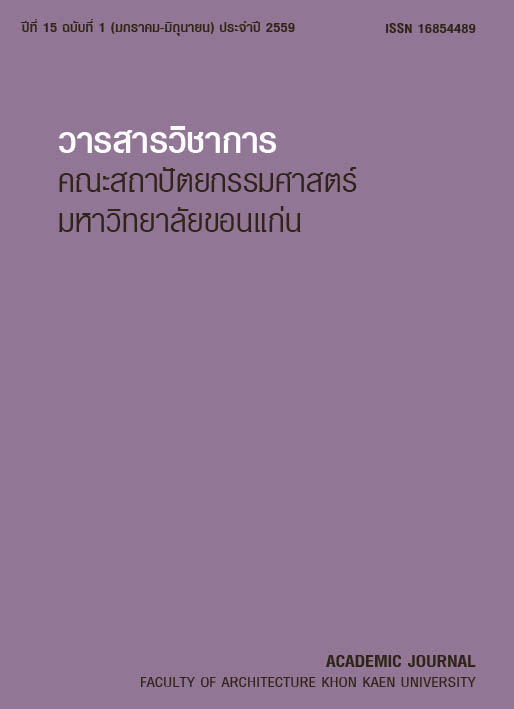สถาปัตยกรรมพระไตรปิฏกและคติกษัตราธิราชพุทธศาสนาในรัชสมัยพระเจ้ามินดง Tripitaka Architecture and Buddhist Kingship in the Reign of King Mindon
คำสำคัญ:
Tripitaka Architecture, Buddhist Kingship, Dhammaraja, Cakkavatti, Mandalaบทคัดย่อ
บทคัดย่อ
สถาปัตยกรรมพระไตรปิฏกในพม่ามีความสำคัญสืบต่อมายาวนานหลายศตวรรษ เมื่อพระเจ้ามินดงทรงสร้างเมืองมัณฑเลย์ในปี 1875 พระองค์โปรดให้มีการก่อสร้างสถาปัตยกรรมสำหรับประดิษฐานพระไตรปิฏกมากถึงสามแห่ง และเป็นส่วนสำคัญในองค์ประกอบตามประเพณีการสร้างเมืองของพม่าที่มีองค์ประกอบ 7 อย่างด้วยกัน บทความนี้มีวัตถุประสงค์เพื่อตรวจสอบนัยยะสำคัญของความหมายของสถาปัตยกรรมพระไตรปิฏกในรัชสมัยของพระเจ้ามินดง โดยมีกรอบแนวคิดที่ใช้อธิบายอยู่บนพื้นฐานของคติกษัตราธิราชของรัฐในพุทธศาสนาเถรวาท ผนวกกับการตีความหมายทางสถาปัตยกรรมตามคติการวางผังสัญลักษณ์จักรวาลวิทยา สถาปัตยกรรมของพระเจ้ามินดงที่เป็นกรณีศึกษาประกอบด้วย พระเจดีย์ Kuthotaw หอพระไตรปิฏก (TripitakaTaik) และวัด Atumashi ผลการศึกษาพบว่า สถาปัตยกรรมนี้เป็นการนำเสนอคติสัญลักษณ์ที่เป็นศูนย์กลางจักรวาล พระเจดีย์ Kuthotaw ซึ่งมีแนววงแหวน 7 วงของอาคารสถูปขนาดเล็กที่ประดิษฐานแผ่นหินจารึกพระไตรปิฏกจำนวน 729 องค์ และการออกแบบวางผังที่ใช้ระบบตารางมณฑล เป็นการแสดงให้เห็นถึงคติศูนย์กลางจักรวาล คือเขาพระสุเมรุ ในขณะที่หอพระไตรปิฏก (TripitakaTaik) และวัด Atumashi ก็มีการวางผังที่ซ้อนลดหลั่นกันเป็นปิรามิดเพื่อเน้นแกนศูนย์กลางอย่างชัดเจน นอกจากจะมีการสร้างวัดจำนวนมากแล้ว พระเจ้ามินดงยังได้ทรงอุปถัมภ์การทำสังคายนาพระไตรปิฏกครั้งที่ 5 ขึ้น ทรงให้มีการคัดลอกพระไตรปิฏกไว้เป็นจำนวนมากรวมทั้งทำการจารึกพระไตรปิฏกทั้งหมดลงบนแผ่นหินไว้ในบริเวณของเจดีย์ Kuthotaw ด้วย พระราชกรณียกิจของพระเจ้ามินดงจึงเป็นการแสดงให้เห็นว่าพระองค์ทรงเป็น “ธรรมราชา” สถาปัตยกรรมพระไตรปิฏกเหล่านี้ยังเป็นสัญลักษณ์ที่สำคัญที่สุดตามคติกษัตราธิราชในรัชสมัยของพระองค์ สถาปัตยกรรมนี้เชื่อมโยงจักรวาลกับกษัตริย์ด้วยคติและพิธีกรรมมณฑลที่เชื่อมโลกกับสวรรค์ อันเป็นมหาจักรวาลและจุลจักรวาลที่แสดงความสัมพันธ์ระหว่างจักรวาลกับพระเจ้ามินดง ในฐานะองค์พระจักรพรรดิราชที่ปกครองด้วยบุญบารมี นอกจากนั้นการที่เจดีย์ Kuthotaw มีแผ่นหินพระไตรปิฏกอันถูกนับรวมเป็นส่วนหนึ่งของสถานที่พิเศษของโลกตามจารีตของพม่าที่จะคงอยู่ตลอดอายุของจักรวาล ก็เพื่อยืนยันว่าเมืองมัณฑเลย์และพระราชอาณาจักรของพระองค์จะดำรงอยู่จนถึงกาลสิ้นกัปป์
Abstract
Tripitaka architecture in Myanmar has been owned a special status for many centuries. When the city of Mandalay was established in 1857, King Mindon built three important Buddhist architecture related to Tripitaka. These were parts of all seven edifices traditionally required when the new city was found. This article aims to investigate the significance meaning of the Tripitaka architecture in the reign of King Mindon. The theoretical framework approaching to this study are the concept of Buddhist kingship of Theravada Buddhist state, together with the interpretation of Buddhist architecture according to cosmological planning. The three targeted Buddhist architecture of King Mindon are studies : Kuthotaw or MahaLawkamarazein Pagoda (the Royal Merit Pagoda), the TripitakaTaik and Atumashi (Incomparable) Monastery. It is found that the architectural symbolism of these Buddhist architecture represent the Buddhist cosmic symbol, a center of the universe. The Kuthotaw which has seven concentric rings of 729 small stupas house the Tripitaka stone inscriptions, encircle the main stupa, and its mandala planning system, certainly represents the center of the universe, Mount Meru. As for the TripitakaTaik and the Atumashi Monastery were also planned as a large stepped pyramid to emphasize the central axis. Apart from building a lot of Buddhist monasteries, King Mindon, as a patronage, arranged the Fifth Great Buddhist Synod. Various copies of Tripitaka were made together with the whole texts of Tripitaka were inscribed on 728 stones, placed in the precinct of the Kuthotaw Pagoda. These were actually an act of a righteous king, a Dhammaraja. Tripitaka architecture became the most important symbol of Buddhist kingship during the time of King Mindon. These architecture link Buddhist cosmology and kingship by rising from the ground in there mandala forms as an embodiment of heaven and earth, the Macrocosm and Microcosm. They represent the image of the universe and figured King Mindon to be a Cakkavatti, a universal ruler who governed by virtue of his merit. Furthermore, the Kuthotaw Pagoda with stone scriptures was added to the list as a fifth peculiar place of the world in Burmese tradition, in order to ensure that the city of Mandalay and the whole kingdom will last until the end of cosmic period.
ดาวน์โหลด
เผยแพร่แล้ว
รูปแบบการอ้างอิง
ฉบับ
ประเภทบทความ
สัญญาอนุญาต
ทัศนะและข้อคิดเห็นของบทความที่ปรากฏในวารสารฉบับนี้เป็นของผู้เขียนแต่ละท่าน ไม่ถือว่าเป็นทัศนะและความรับผิดชอบของกองบรรณาธิการ




